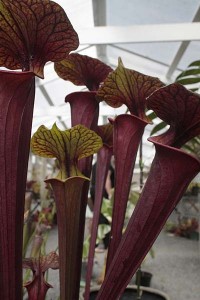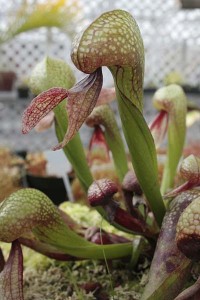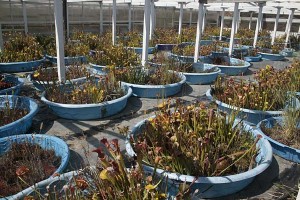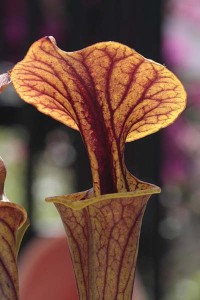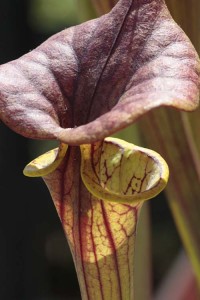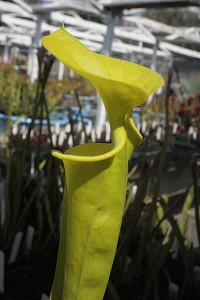On our recent trip we had only one nursery on the list of must-visit locations: California Carnivores in Sebastapol.
Specializing in carnivorous plants from around the world, proprietor Peter D’Amato has assembled a collection of species and hybrids that run the gamut from venus flytraps and American pitcher plants to really cool sundews and bladderworts.
One of the first plants that you encounter is this massed group of the hybrid, Sarracenia x Dana’s Delight. It’s a fairly common plant, but gather together several dozen pots of it in a massed display and there’s nothing common about it. The pitchers color up to a most amazing purplish red when grown in strong sunlight.
Here’s another pitcher plant that had some gorgeous coloration. I forgot to note the name–sorry–but I think it might be a form or hybrid of S. flava.
If there’s a pitcher plant that I covet it’s this one, the California and Oregon cobra lily, Darlingtonia californica. I’ve killed one already, and won’t attempt another until I’m more confident that I can offer it what it needs to survive.
To grow so many different kinds of plants requires a lot of space. Here’s a shot of the propagation ponds.
I left the premises with three plants, a couple more than I really have room for in my bog. I posted yesterday about the amazing fly-catching capabilities of the sundew I bought (Drosera filiformis ssp. filiformis ‘Florida giant’). Another plant was a division of an albino hybrid, Super Green Giant.
The third purchase was this beautifully colored version of the yellow pitcher, Sarracenia flava. Here it is from the front…
…and here it is from behind.
…and for contrast, here’s a form of this species with minimal coloration, ‘Maxima.’ I love its yellow-green coloration.
The basic element of a pitcher plant is a highly developed leaf structure that contains a reservoir of fluid that insects fall into. The bug eventually drowns, and the the digested insect turns into food for the plant.
The more I look at pitcher plants, the more I appreciate the differences between them. It’s like musical variations on a theme, where you start with something simple and recognizable, and then go off into all sorts of amazing directions.
Jenny was out to this coast for a family visit, and was along for this plant trip. Her purchases were two: a small but very pretty and cute bladderwort, Utricularia livida, and a distinctive little venus flytrap, Dionaea muscipula.
The husband’s reaction when we got back to the hotel went something like, “You bought a venus flytrap? To take all the way back to South Carolina? Where venus flytraps come from?” But Jenny is a a curious plant person herself, and the flytrap she picked was a nicely grown specimen that had striking red coloration unlike the typical versions of the species. Like pitcher plants, flytraps can have their own sets of cool variations on the basic theme.



